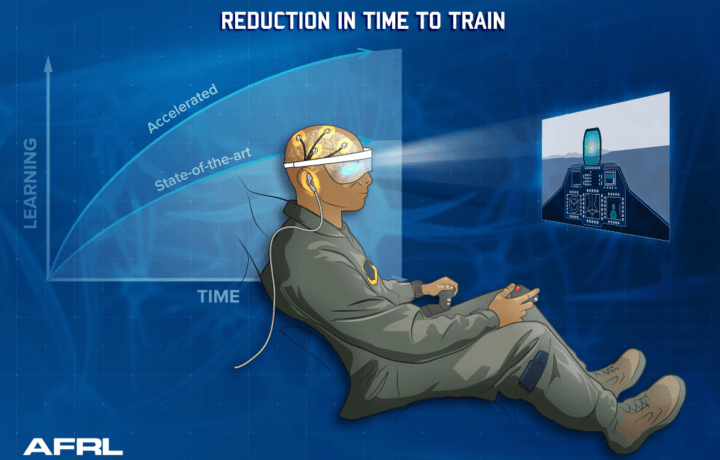As the United States Air Force continues to face a pilot shortage of about 2,100 or roughly 10% of the 21,000 pilots it needs to execute the National Defense Strategy, the service has undertaken a number of initiatives to increase the production of pilots. This has included programs that utilize augmented and virtual reality (AR/VR), but now the Air Force is seeking a more “plug-and-play” solution to train pilots.
In August, the Air Force Research Laboratory (AFRL) team at Wright-Patterson Air Force Base, Ohio (AFNS) announced that it would use electrodes placed inside the ear canal much like an earbud that could enable moments of super learning, even controllable periods of focus to help pilots focus on flight training faster than was thought humanly possible.
Earbud that Produces Super Learning
While it sounds like something out of science-fiction, the Individualized Neural Learning System (iNeuraLS) is really just an augmented learning platform that could enable rapid learning by closed-looped modulation of cognitive states during skill acquisition. The AFRL team has been seeking to develop a capability that could provide Airmen the ability to rapidly acquire knowledge and skills on the fly through direct brain interfaces with a little help from the earbud-sized neurotechnology interface.
The research effort is being led by the AFRL 711th Human Performance Wing (HPW), and was recently named as one of several projects to receive funding as part of the Seedlings for Disruptive Capabilities Program (SDCP). It has brought together teams from various AFRL technical directorates along with their external partners to “seed” new ideas with potentially transformational capabilities.
All of this is very much in line with the Air Force’s 2030 Science and Technology Strategy.
“We are very excited to launch this SDCP effort,” said Dr. Gaurav Sharma, senior technical lead for Cognitive Neuroscience at AFRL, in an official Air Force news release. “Neurotechnology is a major focus area for the 711 HPW, with a huge potential for enhancing capabilities for the Air Force as we move forward.”
Science Reality
Despite the fact that it sounds like something out of a cyberpunk novel where a computer is plugged directly into the brain, this is very much achievable – in part because it isn’t truly plugging in.
“It may sound like science fiction, but it is rooted in science,” added Sharma. “Over the last decade we have made tremendous progress in our understanding of brain function related to Airman performance and have also developed and tested a toolkit of neuromodulation technologies to drive the brain to an optimal performance state.”
iNeuraLS takes this to the next level by creating an immersive closed-loop system that could also be optimized to each user’s learning potential. Neural signals could be used to develop algorithms that would in turn help researchers better determine the optimal brain state under which individuals could receive information.
“We’re going to have unprecedented access to the brain using a novel brain-machine interface,” explained Dr. Nathaniel Bridges, AFRL research biomedical engineer and Neural Interface team lead.
Brain-Computer Interfaces
This new AFRL research is not the first military effort to create a true brain-computer interface (BCI) – a concept first conceived by UCLA computer scientist Jacques J. Vidal in the 1970s. Many past efforts to make it a reality have involved reading the electroencephalography (EEG) – which records electrical activity in the brain by utilizing electrodes placed on the skull.
Last year the Defense Advanced ResearchProjects Agency (DARPA) provided $104 million in funding to the Next-generation Nonsurgical Neurotechnology Program (N³), which was being led by three graduate students at Carnegie Mellon University in Pittsburgh.
The idea was that a direct brain-machine interface could help soldiers act more quickly – even if it would not necessarily speed up their ability to make decisions. However, it could allow a soldier to direct a weapon’s fire or maneuver a vehicle at the speed of thought.
A study released by the RAND Corporation this past August also highlighted how BCI could be used to monitor a soldier’s cognitive workload, control a drone swarm, or link with a prosthetic. That would seem to be just a thought away from controlling a vehicle or firing a weapon.
Of course there are still numerous policy, safety, legal, and most notably ethical issues and considerations before a true BCI could, or should be deployed to soldiers.
In the meantime however, it seems that the next step will be in how the neurotechnology interface could be used as training aid.
“We are working more closely than ever with industry leaders to develop groundbreaking technologies with transformative potential for the Air Force,” said Sharma. “AFRL is committed to developing neurotechnology-enabled solutions to improve warfighter performance, and this partnership is only the beginning.”




